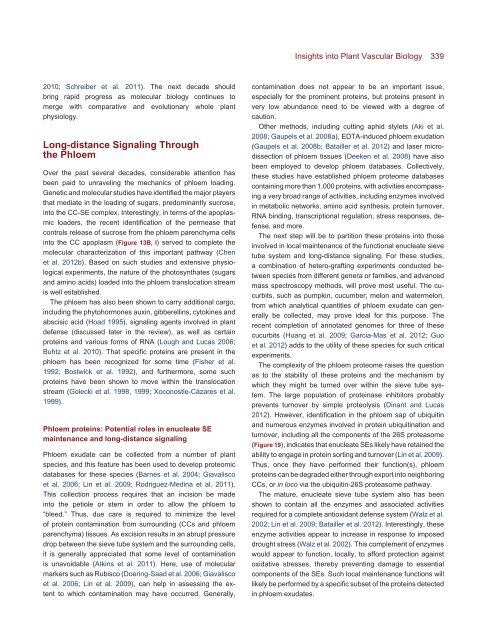The Plant Vascular System: Evolution, Development and FunctionsF
The Plant Vascular System: Evolution, Development and FunctionsF
The Plant Vascular System: Evolution, Development and FunctionsF
You also want an ePaper? Increase the reach of your titles
YUMPU automatically turns print PDFs into web optimized ePapers that Google loves.
2010; Schreiber et al. 2011). <strong>The</strong> next decade should<br />
bring rapid progress as molecular biology continues to<br />
merge with comparative <strong>and</strong> evolutionary whole plant<br />
physiology.<br />
Long-distance Signaling Through<br />
the Phloem<br />
Over the past several decades, considerable attention has<br />
been paid to unraveling the mechanics of phloem loading.<br />
Genetic <strong>and</strong> molecular studies have identified the major players<br />
that mediate in the loading of sugars, predominantly sucrose,<br />
into the CC-SE complex. Interestingly, in terms of the apoplasmic<br />
loaders, the recent identification of the permease that<br />
controls release of sucrose from the phloem parenchyma cells<br />
into the CC apoplasm (Figure 13B, I) served to complete the<br />
molecular characterization of this important pathway (Chen<br />
et al. 2012b). Based on such studies <strong>and</strong> extensive physiological<br />
experiments, the nature of the photosynthates (sugars<br />
<strong>and</strong> amino acids) loaded into the phloem translocation stream<br />
is well established.<br />
<strong>The</strong> phloem has also been shown to carry additional cargo,<br />
including the phytohormones auxin, gibberellins, cytokines <strong>and</strong><br />
abscisic acid (Hoad 1995), signaling agents involved in plant<br />
defense (discussed later in the review), as well as certain<br />
proteins <strong>and</strong> various forms of RNA (Lough <strong>and</strong> Lucas 2006;<br />
Buhtz et al. 2010). That specific proteins are present in the<br />
phloem has been recognized for some time (Fisher et al.<br />
1992; Bostwick et al. 1992), <strong>and</strong> furthermore, some such<br />
proteins have been shown to move within the translocation<br />
stream (Golecki et al. 1998, 1999; Xoconostle-Cázares et al.<br />
1999).<br />
Phloem proteins: Potential roles in enucleate SE<br />
maintenance <strong>and</strong> long-distance signaling<br />
Phloem exudate can be collected from a number of plant<br />
species, <strong>and</strong> this feature has been used to develop proteomic<br />
databases for these species (Barnes et al. 2004; Giavalisco<br />
et al. 2006; Lin et al. 2009; Rodriguez-Medina et al. 2011).<br />
This collection process requires that an incision be made<br />
into the petiole or stem in order to allow the phloem to<br />
“bleed.” Thus, due care is required to minimize the level<br />
of protein contamination from surrounding (CCs <strong>and</strong> phloem<br />
parenchyma) tissues. As excision results in an abrupt pressure<br />
drop between the sieve tube system <strong>and</strong> the surrounding cells,<br />
it is generally appreciated that some level of contamination<br />
is unavoidable (Atkins et al. 2011). Here, use of molecular<br />
markers such as Rubisco (Doering-Saad et al. 2006; Giavalisco<br />
et al. 2006; Lin et al. 2009), can help in assessing the extent<br />
to which contamination may have occurred. Generally,<br />
Insights into <strong>Plant</strong> <strong>Vascular</strong> Biology 339<br />
contamination does not appear to be an important issue,<br />
especially for the prominent proteins, but proteins present in<br />
very low abundance need to be viewed with a degree of<br />
caution.<br />
Other methods, including cutting aphid stylets (Aki et al.<br />
2008; Gaupels et al. 2008a), EDTA-induced phloem exudation<br />
(Gaupels et al. 2008b; Batailler et al. 2012) <strong>and</strong> laser microdissection<br />
of phloem tissues (Deeken et al. 2008) have also<br />
been employed to develop phloem databases. Collectively,<br />
these studies have established phloem proteome databases<br />
containing more than 1,000 proteins, with activities encompassing<br />
a very broad range of activities, including enzymes involved<br />
in metabolic networks, amino acid synthesis, protein turnover,<br />
RNA binding, transcriptional regulation, stress responses, defense,<br />
<strong>and</strong> more.<br />
<strong>The</strong> next step will be to partition these proteins into those<br />
involved in local maintenance of the functional enucleate sieve<br />
tube system <strong>and</strong> long-distance signaling. For these studies,<br />
a combination of hetero-grafting experiments conducted between<br />
species from different genera or families, <strong>and</strong> advanced<br />
mass spectroscopy methods, will prove most useful. <strong>The</strong> cucurbits,<br />
such as pumpkin, cucumber, melon <strong>and</strong> watermelon,<br />
from which analytical quantities of phloem exudate can generally<br />
be collected, may prove ideal for this purpose. <strong>The</strong><br />
recent completion of annotated genomes for three of these<br />
cucurbits (Huang et al. 2009; Garcia-Mas et al. 2012; Guo<br />
et al. 2012) adds to the utility of these species for such critical<br />
experiments.<br />
<strong>The</strong> complexity of the phloem proteome raises the question<br />
as to the stability of these proteins <strong>and</strong> the mechanism by<br />
which they might be turned over within the sieve tube system.<br />
<strong>The</strong> large population of proteinase inhibitors probably<br />
prevents turnover by simple proteolysis (Dinant <strong>and</strong> Lucas<br />
2012). However, identification in the phloem sap of ubiquitin<br />
<strong>and</strong> numerous enzymes involved in protein ubiquitination <strong>and</strong><br />
turnover, including all the components of the 26S proteasome<br />
(Figure 19), indicates that enucleate SEs likely have retained the<br />
ability to engage in protein sorting <strong>and</strong> turnover (Lin et al. 2009).<br />
Thus, once they have performed their function(s), phloem<br />
proteins can be degraded either through export into neighboring<br />
CCs, or in loco via the ubiquitin-26S proteasome pathway.<br />
<strong>The</strong> mature, enucleate sieve tube system also has been<br />
shown to contain all the enzymes <strong>and</strong> associated activities<br />
required for a complete antioxidant defense system (Walz et al.<br />
2002; Lin et al. 2009; Batailler et al. 2012). Interestingly, these<br />
enzyme activities appear to increase in response to imposed<br />
drought stress (Walz et al. 2002). This complement of enzymes<br />
would appear to function, locally, to afford protection against<br />
oxidative stresses, thereby preventing damage to essential<br />
components of the SEs. Such local maintenance functions will<br />
likely be performed by a specific subset of the proteins detected<br />
in phloem exudates.
















